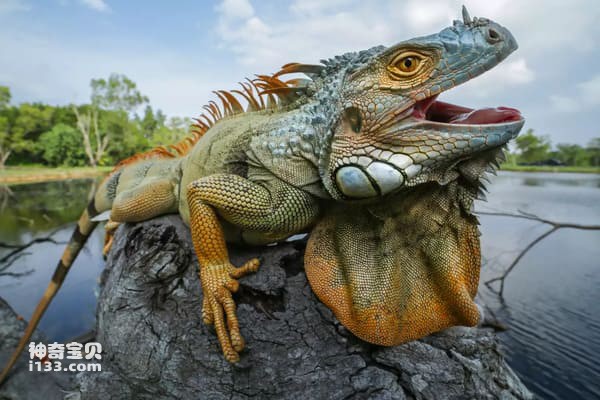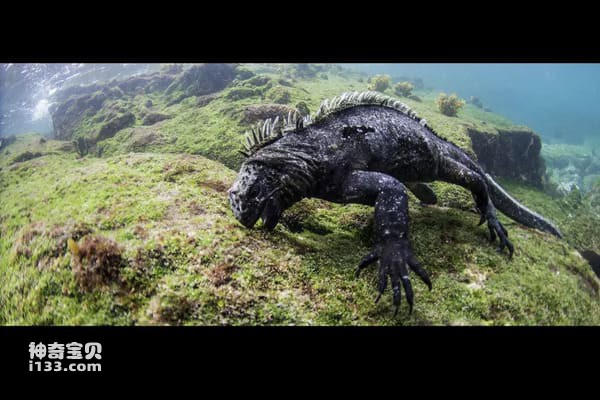There are more than 30 species of iguanas, belonging to the class Reptiles. Depending on the species, iguanas' habitats range from swamps and lowlands to deserts and rainforests. Iguanas are divided into nine broader species categories: Galapagos marine iguana, Fiji iguana, Galapagos land iguana, spiny-tailed iguana, spiny-tailed iguana, rock iguana, desert iguana lizards, green iguanas and kakwalas.

Scientific name: Iguanaidae
Common name: Common Iguana (green iguana)
Order: Squamata
Basic Animal Group: Reptiles
Size: Maximum 5 to 7 feet (green iguana), minimum 5 to 39 inches (spiny-tailed iguana)
Weight: Up to 30 pounds (blue iguana)
Lifespan: Average 4 to 40 years, depending on species
Diet: fruits, flowers, leaves, insects and snails
Habitat: Rainforest, lowlands, swamps, deserts
Population: Approximately 13,000 Fiji iguanas per species; 3,000 to 5,000 spiny-tailed iguanas per species; 13,000 to 15,000 green iguanas per species
Conservation status: Least Concern (Green Iguana), Endangered (Fiji Iguana), Critically Endangered (Fiji Crested Iguana)
Fun fact: Marine iguanas are excellent swimmers.

Portrait of iguana sitting on a tree branch.
Iguanas are cold-blooded, egg-laying animals and are among the largest lizards found in the Americas. Their size, color, behavior and unique adaptations vary from species to species. Some iguanas, like the Fiji spotted iguana, are bright green with white or light blue stripes, while others are darker. The most abundant and best-known species of iguana is the green iguana (Iguana iguana). Their average size is 6.6 feet and they weigh up to 11 pounds. Their green color helps camouflage them in the bush, and their bodies have a row of spines that serve as a defense.
Rock iguanas have long, straight tails and short, powerful limbs that help them climb trees and limestone formations. They have a flap of skin called a dewlap in their throat area that helps regulate temperature. The spiny-tailed iguana is a large omnivore and the black spiny-tailed iguana is the fastest lizard, reaching speeds of up to 21 mph.

Marine iguanas feed on algae-covered rocks.
Marine iguanas are black in color to help warm their bodies after swimming in cold waters. They have no gills and therefore cannot breathe underwater. However, marine iguanas can hold their breath underwater for up to 45 minutes. Their flat tails help them swim like snakes, allowing them to quickly eat algae for several minutes before returning to the surface. Their long claws enable them to grip the bottom while grazing. Due to their diet and consumption of large amounts of salt water, marine iguanas have developed the ability to sneeze excess salt through their salt glands.
Depending on the species, iguanas live in a variety of habitats, including deserts, rocky areas, swamps, rainforests, and lowlands. Green iguanas can be found throughout Mexico, into Central America, the Caribbean Islands, and southern Brazil. The species of iguanas that inhabit the Caribbean islands are collectively known as rock iguanas. Desert iguanas are found in the southwestern United States and Mexico, while the Galapagos Islands are home to two species of marine iguanas.
Most iguanas are herbivores, eating young leaves, fruits, and flowers. Some feed on insects such as wax worms, while marine iguanas dive into the ocean to harvest algae from plants. Some species contain bacteria in their digestive systems that enable them to ferment the plant material they eat.
Green iguanas are omnivores when young, but switch to an almost entirely herbivorous diet as adults. Young iguanas eat mainly insects and snails, switching to fruits, flowers and leaves as adults. They have sharp teeth that can tear leaves. Green iguanas also live high in the tree canopy and, as they age, inhabit higher altitudes. Another interesting fact about iguanas is that they can detach their tails when in danger and regrow them later.
Iguanas typically reach sexual maturity at 2 to 3 years of age and can lay 5 to 40 eggs per clutch, depending on the species. In the case of green iguanas, males mate with females during the rainy season and leave the treetops to fertilize their eggs at the beginning of the dry season.
Most iguana species dig a burrow in a sunny location, lay their eggs inside and cover them. The ideal temperature range for these eggs to hatch is 77 to 89 degrees Fahrenheit. After 65 to 115 days, depending on the species, the pups hatch at the same time. After being dug out of their burrow, the newly hatched iguanas begin their lives.

The Fiji Crested Iguana (Brachylophus vitiensis) lives on the Fiji Island of Viti Levu. It is a critically endangered iguana species found on some islands in Fiji.
There are approximately 35 species of iguanas in existence. The most abundant species is the common iguana or green iguana (Iguana). According to habitat and adaptability, iguanas are divided into 9 categories: Galapagos marine iguana, Fiji iguana, Galapagos land iguana, spiny-tailed iguana, spiny-tailed iguana, rock iguana, Desert iguanas, green iguanas and chuckwallas.
The Fiji iguana is an endangered species, with the Fiji crested iguana listed as critically endangered. The biggest factors in the decline of Fiji's iguanas are predation by invasive species of feral cats (Felis catus) and black rats (Rattusrattus). In addition, the crested iguana is also seriously threatened due to the rapid loss of dry and healthy forest habitat in the Fiji Islands. This habitat loss is caused by clear-cutting, burning, and converting forests to farmland.
According to the International Union for Conservation of Nature (IUCN), green iguanas are designated as animals of least concern. According to the International Union for Conservation of Nature, all species in the Fiji iguana group are listed as endangered, with the Fiji crested iguana (Brachylophus vitiensis) listed as critically endangered.
Green iguanas are the most common reptile pet in the United States, but because they are difficult to care for, many pets die within the first year. In Central and South America, green iguanas are raised on farms and eaten by people. Their eggs are considered a delicacy and are often referred to as "tree chickens."
animal tags:
We created this article in conjunction with AI technology, then made sure it was fact-checked and edited by a Animals Top editor.